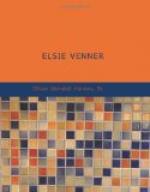There was no possible objection to this arrangement, if the parties interested had seen fit to make it or even to think of it. But “Portia,” as some of the mansion-house people called her, did not happen to awaken the elective affinities of the lonely widower. He met her once in a while, and said to himself that she was a good specimen of the grand style of woman; and then the image came back to him of a woman not quite so large, not quite so imperial in her port, not quite so incisive in her speech, not quite so judicial in her opinions, but with two or three more joints in her frame, and two or three soft inflections in her voice, which for some absurd reason or other drew him to her side and so bewitched him that he told her half his secrets and looked into her eyes all that he could not tell, in less time than it would have takes him to discuss the champion paper of the last Quarterly with the admirable “Portia.” Heu, quanto minus! How much more was that lost image to him than all it left on earth!
The study of love is very much like that of meteorology. We know that just about so much rain will fall in a season; but on what particular day it will shower is more than we can tell. We know that just about so much love will be made every year in a given population; but who will rain his young affections upon the heart of whom is not known except to the astrologers and fortune-tellers. And why rain falls as it does and why love is made just as it is are equally puzzling questions.
The woman a man loves is always his own daughter, far more his daughter than the female children born to him by the common law of life. It is not the outside woman, who takes his name, that he loves: before her image has reached the centre of his consciousness, it has passed through fifty many-layered nerve-strainers, been churned over by ten thousand pulse-beats, and reacted upon by millions of lateral impulses which bandy it about through the mental spaces as a reflection is sent back and forward in a saloon lined with mirrors. With this altered image of the woman before him, his preexisting ideal becomes blended. The object of his love is in part the offspring of her legal parents, but more of her lover’s brain. The difference between the real and the ideal objects of love must not exceed a fixed maximum. The heart’s vision cannot unite them stereoscopically into a single image, if the divergence passes certain limits. A formidable analogy, much in the nature of a proof, with very serious consequences, which moralists and match-makers would do well to remember! Double vision with the eyes of the heart is a dangerous physiological state, and may lead to missteps and serious falls.




